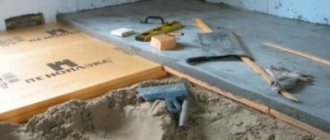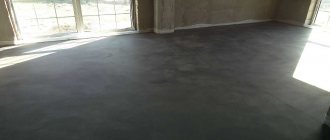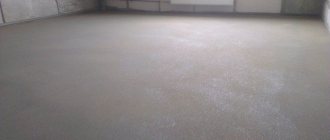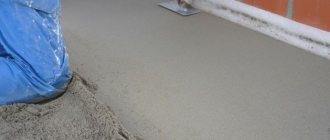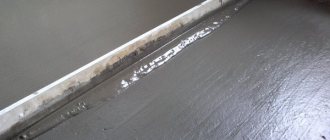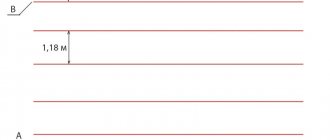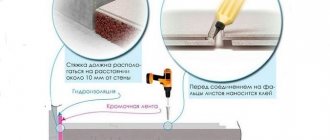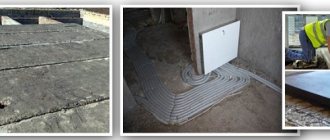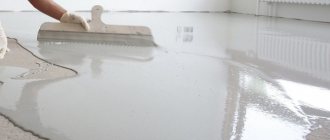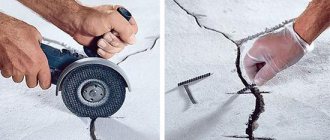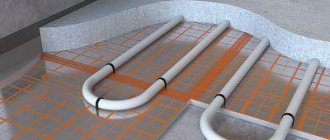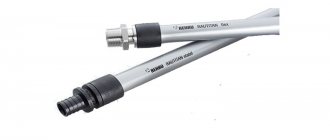Other articles on this topic:
⇒ Floors on the ground on the first floor of a private house without a basement. ⇒ How to make the right concrete floor in a wooden or frame house.. ⇒ Wooden floor on joists in a private house. ⇒ Floor with dry prefabricated screed made of gypsum fiber board, chipboard, OSB or plywood
In order to properly make a floor screed based on cement mortars and concrete, the screed must correspond to the purpose of the room and have the necessary parameters for this.
The screed can become a solid foundation for the floor in any room of the house. Cement screed is not afraid of moisture and is convenient to use as a base for flooring in damp rooms, as well as outside the house - on terraces, in the garage. The installation of heated floors in rooms is also not complete without a screed.
Screed solutions
Cement-sand mortar for screed
To install screeds, use a traditional cement-sand mortar of a grade not lower than M75. To prepare the solution, prepare a mixture of one part cement and three parts sand. The strength of the finished screed increases if the solution for laying the screed has a thick consistency.
Cement-sand mortar is easier to prepare and easier to lay in a screed than concrete. But the consumption of cement for constructing a screed of the required strength is greater than for concrete. Therefore, a mortar screed turns out to be more expensive than a concrete one.
Cement-sand mortar is recommended for use in thin-layer screeds.
Lime should not be added to the solution. Although lime increases the plasticity of the mortar, it reduces the strength of the screed.
Concrete of normal, densely plastic consistency
Concrete of classes B10, B15, B20 is used for constructing screeds. Crushed stone and gravel are used as concrete filler. The size of the filler granules must be at least three times smaller than the thickness of the screed.
Concrete for semi-dry screed (prance)
To prepare concrete for semi-dry screed, significantly less water is used than usual. A semi-dry screed has a higher compressive strength (up to 35 mPa) than screeds made from mortar and plastic concrete. In addition, it is less susceptible to shrinkage, which reduces the risk of cracks in the screed.
Semi-dry screed is suitable for installing heated floors. It is convenient to prepare concrete for semi-dry screed on a construction site in a special concrete mixer - mixocrete, which prepares the concrete and immediately supplies it with a pneumatic pump through a flexible pipe to the laying site.
Rough screed made of cement-sand mixture - step-by-step instructions
Now let’s move on to considering the most popular version of a rough screed in a private house - “wet” and created from a cement-sand mixture.
Step 1. The site is prepared - all construction waste is removed from it. Since in this case the screed is created on the ground floor of the future private house on the ground, sand is poured into the pit in place of the room and carefully compacted.
Sand is compacted
Advice! Watering it with a small amount of water and repeating the tamping process helps make the sand cushion much denser.
Step 2. Next, the compacted sand is finally leveled using a rule or an ordinary wooden board.
Leveling compacted sand
Step 3. Waterproofing is laid on top of the sand cushion - it can be ordinary polyethylene (an economical option), roofing felt (reliable, but difficult to prepare and join) or specialized, especially strong films that create an airtight layer.
Laying waterproofing
Step 4. Thermal insulation is laid on top of the film - it will not only help create a “floating screed” that is not afraid of shrinkage and changes in the walls of the house, but will also protect the floors on the first floor from the cold during autumn, winter and spring.
Laying insulation boards
Step 5. A damper tape is laid along the perimeter of the future screed.
Damper tape
Step 6. Wire mesh reinforcement is laid on the insulation layer. It is placed on supports so that it lies approximately in the middle of the screed material and imparts tensile and bending strength to the cement-sand mortar.
Reinforcement mesh laid
Step 7. Beacons are placed on top of the insulation and fittings at a preset level. In this case, their position must be carefully controlled using a level.
Beacons are being placed
Lighthouses on display
Step 8. The most important stage in creating a rough floor screed is mixing the cement-sand mixture and pouring it. The grade of the mixture is not lower than M75-M100; in the presence of high dynamic loads, the solution should be much stronger.
The solution must be strong enough
Proportions of cement in relation to sand for preparing a mortar of a certain strength grade
Step 9. The prepared and poured cement-sand mixture is smoothed using the rule. Then the perfectly flat surface is covered with polyethylene and left for some time so that the screed gains strength and dries. At the same time, it is sometimes watered with a small amount of moisture.
Smoothing the mixture
Video - Rough semi-dry screed - all the key points
Composition of cement mortars for concrete floor screed
Cement mortars and concrete can be prepared at the construction site. It is recommended to include additives in their composition to increase plasticity, accelerate setting and reduce water permeability of the screed.
To obtain concrete of the required compressive strength class, it is recommended to use the following grades and quantities of cement:
During storage, cement loses its activity. The cement consumption indicated in the table is indicated for cement with a shelf life of no more than two months. The consumption of cement with a shelf life under normal conditions of more than 3 months is increased by 20%; more than 6 months - by 30-40%.
It is not recommended to use cement with a shelf life of more than 12 months.
When using old cement, the mixing time of the mixture is increased by 2-4 times. It is recommended to introduce additives that accelerate concrete hardening.
To prepare medium-strength concrete, use a mixture of 1 part (by volume) cement, 2.5 parts medium-sized sand and 4 parts aggregate - gravel or crushed stone.
The indicated ratio of mixture ingredients is approximate and depends on many factors. For example, the amount of sand in the mixture should be sufficient to fill all the spaces between the aggregate granules. For large granule sizes, the amount of sand is slightly increased, and for fine aggregate, on the contrary, it is reduced. Cement consumption is also adjusted depending on its brand, shelf life and required concrete strength (see table above).
The prepared cement mortar must have good plasticity and mobility. This solution is easier to level and compacts better. To increase plasticity, special additives are used - sulfite-yeast mash (SYB) in an amount of 0.15-0.25% by weight of cement; soap naft (M1) - 0.1-0.2% by weight of cement, and others. At home, craftsmen often add a small amount of grated laundry soap to a concrete mixer.
The mobility of the concrete mixture also depends on the ratio between sand and crushed stone. The best mobility is achieved at a certain optimal ratio, at which the thickness of the cement paste layer is maximum. When the sand content in the aggregate mixture exceeds this value, the concrete mixture becomes less mobile, which is explained by the increase in the surface area of the aggregate mixture.
To make the concrete mixture plastic, much more water is often added to concrete than necessary (40...70% by weight of cement). Concrete should not be made too liquid,
adding a lot of water. A screed made from such concrete will take several months to dry and will have reduced strength and frost resistance. The risk of significant shrinkage and cracking of the screed increases.
Excess water that has not entered into a chemical reaction with cement remains in the concrete in the form of water pores and capillaries or evaporates, leaving air pores. In both cases, the concrete will be weakened by the presence of pores and the more water, the more pores and thus the less strength and frost resistance of the concrete.
Dry mixtures for floor screed
The best option, although more expensive, is to use ready-made dry mixtures for screeding. Such mixtures are commercially available on the construction market. The mixture already includes the necessary additives.
Manufacturers can include microfiber in the mixture - fibers that serve as reinforcement. Microfiber screed is more resistant to shrinkage and cracking.
There are mixtures specifically designed for underfloor heating. This should be indicated on the packaging of the mixture.
There are quick-setting compounds. Floor tiles can be laid on a screed made from this mixture within 24 hours.
The packaging of the dry mixture should contain information about what screeds and installation conditions it is intended for, what compressive strength of the screed the use of the mixture will provide.
For residential premises, the compressive strength of the screed must be at least 12 MPa, for a garage - at least 20 MPa.
Where to buy cheap dry mix for screed in your city
Dry mix for screed
⇆
Types of floor screeds
By design, screeds can be connected to the base on which they are laid, or laid on a separating layer, or floating.
Screeds connected to the base are performed if the base is also made of concrete. For example, a screed on a reinforced concrete floor slab or on a concrete floor preparation. To ensure adhesion of the screed to the base, the surface of the latter is specially prepared - dust-free and primed. The minimum thickness of the screed is 2.5 cm.
In screeds, on the separating layer between the concrete base (reinforced concrete slab or concrete preparation) and the screed, a layer of waterproofing film with a thickness of at least 0.2 mm is laid. The edges of the film panels are laid with an overlap of at least 10 cm and sealed with adhesive tape. The edges of the film are wrapped on the walls.
The film separating layer prevents water leakage from freshly laid concrete. Dewatering of concrete reduces the strength of the screed. The screed concrete must be laid on a separating layer of film in all cases where water leakage from the concrete into the base of the screed is possible.
The minimum thickness of the screed on the separating layer is 3.5 cm.
A floating screed is laid on a layer of insulation or sound insulation, for example, when installing a floating floor or a floor on the ground. The minimum thickness of the screed is 4.5 cm, subject to reinforcement. A floating screed with a thickness of more than 7-8 cm may not be reinforced.
How to make a dry floor screed
Step 1. The base is prepared in the same way as for installing a wet screed. The horizontal level of the future floor is determined using a laser level.
Preparing the base
Step 2. Damper tape is glued to the walls around the perimeter of the room. Also, the latter can simply be laid around the perimeter without gluing - the main thing is that it is at least somehow fixed.
Fixing the damper tape
Step 3. The floor is partially backfilled with expanded clay with a fraction size of up to 4 mm. Expanded clay is simply poured onto the floor in those places where the guides for the gypsum fiber will be located.
Partial filling with expanded clay
Attention! When laying dry screed, using beacons will also not hurt. They will help make the expanded clay layer smoother. They just need to be removed before further work.
Step 4. Guide rails are laid on the expanded clay layer and leveled.
Installation of guides
The guides need to be level
Another photo of the process
Step 5. The floor between the two installed guides is covered with the remaining expanded clay.
The remaining expanded clay is poured
Step 6. The expanded clay is leveled using the rule. In this case, the rule is laid on previously mounted guides. The level of expanded clay should be slightly lower than the level of the upper border of the guides. It is not worth moving on the leveled layer of expanded clay.
Leveling expanded clay using the rule
Step 7. Laying of gypsum fiber sheets begins. Since the corners of the individual 4 sheets should not meet at one point, the sheets are laid staggered. To do this, you may need to cut individual sheets into two parts or elements of the required size.
Cutting gypsum fiber
Step 8. The first sheet of gypsum fiber is placed in the corner of the room, its locking edge is coated with adhesive.
The edge of the first sheet is coated with glue
Step 9. The second sheet of gypsum fiber is laid, followed by the third and so on.
Laying the second sheet
Step 10. The technology for laying sheets in subsequent rows is exactly the same - first, the edges of the laid sheets are coated with glue, and then the next floor elements are laid.
Laying subsequent rows
Step 11. Additionally, the floor elements are fastened together using special gypsum fiber screws, which are screwed along the perimeter of the sheets. The screed is ready.
Screwing in plasterboard screws
Prices for GVL for dry floor screed
gvl for floor
Video - Making a dry screed
Technology of floor screeding in a private house
The screed is laid at a base and air temperature above +5 degrees C. The technology for laying screed does not change depending on whether cement-sand mortar or concrete, including semi-dry consistency, is used for laying.
The work is performed in the following sequence.
Prepare the base on which the screed will be laid. For a screed connected to the base, the surface of the base is cleaned of debris, dusted with a vacuum cleaner and primed.
To install a screed on a separating layer and a floating one, a layer of sound and heat insulation is laid, and a separating layer of waterproofing film is laid on top.
On walls and other vertical structures, strips of polystyrene foam or edging tape made of polyurethane foam 1-2 cm thick are attached to glue to create an expansion joint.
Guide rails - beacons - are laid on cakes of quickly setting cement mortar. Beacons are laid over the entire surface of the base in parallel rows with a pitch of approximately 1.5 m and at a distance of 20 cm from the walls. Wooden slats or various metal profiles and pipes are used as beacons.
Special galvanized steel profiles for installing beacons are available for sale. Profiles are convenient because they do not need to be removed from the screed layer. But such profiles have low mechanical strength, increased flexibility and require careful alignment when installing on flats and care when pouring concrete.
The upper surface of the beacons is leveled in one plane. If necessary, provide the required plane slope.
The solution prepared in a concrete mixer is supplied to the work site, and moving towards the door, it is evenly distributed between the beacons so that the thickness of the solution is slightly higher than the level of the beacons.
Using a grater, the solution is pre-distributed between the beacons and compacted. Finally, the solution is leveled with a wooden or metal lath - usually by moving it along the beacons in a zigzag motion towards itself. If shells remain behind the lath in the screed, they are filled with mortar and leveled again using the rule.
After the solution begins to harden and can support the weight of the worker, the beacons are removed from the screed. This is done in a timely manner, until the solution has completely set, and carefully so as not to damage the screed. If a semi-dry screed is laid, then the beacons can be removed within 3-4 hours.
The gaps in the screed left after removing the beacons are filled with mortar and smoothed with a grater, making circular movements.
Until the mortar has completely hardened, furrows are made in certain places on the screed, cutting through the mortar with a spatula to the required depth. After the solution has set, such grooves will have to be cut with a power tool with a diamond blade.
Expansion joints in the screed
The wall expansion joint separates the screed from the walls and other vertical structural elements of the building - columns, staircase supports, etc. The seam is necessary in order to eliminate the mutual transfer of stresses between the screed and the structures of the house. Stresses can arise as a result of thermal expansion of materials or their shrinkage, as well as as a result of deformations under the influence of loads.
In addition, the seam improves the sound insulation of rooms, making it difficult to transmit sounds from the walls to the floor structures and back.
To create a seam along the walls and other elements of the building, an elastic tape 1 cm thick is secured to the entire height of the screed.
When placing underfloor heating pipes in a screed, an expansion joint across the entire thickness of the screed separates the adjacent fields of underfloor heating pipes.
In addition to the expansion joint near the walls, cuts are made in the screed, which divide the screed into smaller rectangular sections. One side of the area should be no more than 3-6 m in size. In narrow corridors, compensation cuts are made across the corridor, every 2-2.5 times the width of the corridor.
In addition, compensation cuts are made at the junction of different floor coverings, as well as at the boundary of changes in screed thickness, in door openings and in other openings at the boundary of different rooms of the house.
Compensation cuts are necessary to compensate for the shrinkage of the screed material during drying. Without them, cracking of the screed may occur. The cuts are made to a depth of 1/3 - 1/2 of the thickness of the screed. The width of the cuts depends on the thickness of the screed and the presence of heated floor pipes in the screed.
If the screed is reinforced with mesh, then the expansion cuts should be located above the joints of individual mesh sheets.
If the floor covering along the screed is tiles, then the compensation cut should coincide with the joint of the tiles.
Compensation cuts may remain empty if the flooring is parquet or laminate. The cuts are filled with waterproof silicone sealant if the floor covering is tile.
Making a wet screed
Step 1. First of all, prepare all the necessary tools and materials. This is a building level, slats that will act as beacons, screws and dowels, building mixtures, sand and cement, usually a hammer drill.
What is needed to arrange a wet screed
Calculator for calculating the amount of ingredients of a mortar for floor screed
Go to calculations
Step 2. The base is cleared of debris and thoroughly prepared as described above.
The base must be properly prepared
Step 3. Using thread, a marker and a tape measure, mark the places for screwing in the screws - they will help install the beacons. The places where the self-tapping screws are screwed in should be located on the same line. In this case, the distance between separately located points should not exceed the length of the rule.
Places for screwing in self-tapping screws are marked
The places where the self-tapping screws are screwed in should be located on the same line
Step 4. Self-tapping screws are screwed into the rough base. To do this, holes are drilled in the floor, and then dowels are inserted into them, into which the fasteners are screwed.
A hole is drilled in the floor
Dowel is inserted
The dowel with the self-tapping screw is clogged
Step 5. The height of the screws is adjusted using a screwdriver. They should be located at the same level relative to each other. Determining the horizontal level is simple - to do this, you need to find the zero mark on the wall, that is, draw a line around the perimeter that will have the same level everywhere. The most convenient way to do this is using a laser level. The minimum thickness of the screed will be in the place where the highest point of the base will be located.
The height of the screws is adjusted using a screwdriver
Step 6. The horizontality of the installed screws is checked using a building level. It is applied to all elements, that is, the determination of horizontality is made over the entire surface of the floor.
Using a building level
Step 7. Beacons are installed. In the area of the self-tapping screws, a small amount of mortar is applied to the base on both sides.
A little mortar is applied
Step 8. The beacon strip is placed on the mortar so that its lower part rests against the head of the screw. Slats made of oak or metal can be used as beacons. The distance between beacons usually does not exceed 1.5 m. Beacons are installed. A damper tape is glued around the perimeter.
Beacon installation
Beacons installed
Step 9. Prepare the mortar. To do this, cement of a grade of at least M400 is mixed with sand in a ratio of 1:3. The mixture is mixed with a construction mixer, water is gradually added to it to make it plastic (approximate consumption - 1 liter per 5 kg of mixture). The result should be a homogeneous, evenly mixed mixture with the consistency of thick sour cream, which is kept for about 5 minutes and mixed again. The prepared mortar is applied to the base between the beacons. It is recommended to start laying out the mortar and creating the screed from the corner farthest from the exit from the room.
The prepared solution is laid out
Attention! Experienced experts advise adding ingredients to water, and not vice versa. Then it will be easier to stir the composition without forming sediment at the bottom of the container.
Step 10. Using the rule, the solution is leveled. In this case, the rule bar is placed with its edges on the beacons and moves along them. This makes it possible to level the screed. All work on creating a screed is carried out in a similar way.
The solution is leveled using the rule
The minimum thickness of the screed is 2 cm in the case of pouring without reinforcement, and with it - all 4 cm. The dimensions of its single piece should not be more than 4 m, otherwise it may crack under the influence of temperature and humidity changes.
Attention! If the screed is poured onto any communications (for example, a heated floor system), then its thickness above them should not be less than 2 cm.
How to dry screed
When working with a cement mixture, it is important to follow some requirements so that the screed dries properly and does not crack:
- The solution sets quickly enough, so it is recommended to complete the work of pouring screed in one room in a day. Typically, the initial hardening of the mixture occurs within a day at a temperature of +20 degrees;
- You cannot dry the screed quickly - it may crack if it does not have the opportunity to dry naturally;
- You cannot move on fresh screed for the first 7 days;
- the period for complete drying and the possibility of further work indoors is 28 days;
- For the first 2-3 days, it is recommended to spray the screed with water, compensating for the evaporation of moisture. The floor can also be covered with plastic sheeting, which is removed after about 2 weeks.
How long does it take for floor screed to dry?
On a note! After a couple of days, the beacons can be removed if desired by filling the resulting cavities with cement mortar. But you don't have to do this.
We evaluate quality
Determining whether the screed turned out well is easy. The color of the finished base should be gray, and the surface should be perfectly smooth. The last indicator will help determine the building level laid on the floor - if the gap between it and the floor is only 2 mm, then the screed is level. Also, the base should be hard to the touch - even when hit with a hammer, the latter will leave minor marks on the surface.
Example of a finished floor screed
Video - How to make a wet screed
How to properly reinforce a screed
Be sure to reinforce thin ties 4.5-5 cm thick on a separating layer of film. Floating screeds, the base of which is a layer of insulation (sound insulation) or compacted soil, are reinforced with a screed thickness of 7-8 cm or less.
If the screed has a thickness greater than that specified above, then the need for reinforcement is determined depending on the operational load. For example, it is recommended to reinforce a floor screed in a garage for a car or on an open terrace on compacted soil with a screed thickness of up to 10 cm.
Screeds made from a ready-made dry mixture containing reinforcing microfiber fibers in many cases do not require additional reinforcement.
Typically, the screed is reinforced with a mesh of steel wire with a diameter of 3-4 mm. The mesh should have cells measuring 100x100 or 150x150 mm.
The steel mesh is laid on spacer pads so that it is approximately in the middle of the screed layer. The protective layer of concrete up to the mesh must be at least 2 cm in rooms, and at least 4 cm when the concrete screed comes into contact with the ground.
On top of the mesh, as usual, beacons are placed on cakes of mortar and leveled.
Various variations of ties
The floor screed in an apartment can be different. First of all, there are options based on the manufacturing method:
- Dry variety. This is the simplest method. To create a flat surface, a dry mixture of materials is poured, and sheets of plasterboard or plywood are installed on top. It often happens that it is impossible to completely correct existing defects, then a finishing layer of liquid solution is used.
Dry floor screed - Wet variety. This variation is a composition that is most often made based on cement or gypsum, as well as a mixture of them. To achieve the required consistency, the products are diluted with water to a liquid state. The material is applied to the prepared base and leveled. To provide additional rigidity, a reinforcing layer is added. Wet screed with reinforcement
- Semi-dry variety. It is a mixture with a minimum amount of water, which is required only to impart the necessary characteristics to the cement.
Leveling the floor using the semi-dry method
It is advisable to decide in advance what kind of floor screed is needed in a particular situation.
Screed in an apartment can be done with a different number of layers:
- Single layer coating. The solution is applied immediately to the required thickness. This option has a significant drawback: if the drying regime is not followed correctly, there is a high probability of cracks appearing.
- Multilayer. It consists of two interconnected surfaces: rough and finishing. The first coating is necessary to correct significant deficiencies and ensure optimal rigidity, therefore it has a thickness of 2 cm. The second - finishing, creates a smooth layer, its thickness ranges from 3 to 15 mm.
Multilayer screed device
Thus, if necessary, it is possible to select the optimal option for obtaining a surface that will serve as an ideal basis for further work. All varieties allow you to do the floor screed yourself.
Thickness and level of screed in the premises of the house
When choosing the thickness of the screed, the strength of the base on which the screed is laid, the presence or absence of screed reinforcement and the operational load are taken into account. In addition, there are restrictions on the minimum thickness of different types of screed (see sections of the article above).
In different rooms of the floor, the thickness of the screed, chosen for design reasons, may be different. For example, the thickness of the screed in rooms with heated floors should be such as to cover the heating tubes with a layer of at least 3 cm.
It is convenient in the house to have floors located in all rooms of the floor on the same level. Only in rooms where water can be spilled on the floor - in a bathroom, toilet, it is recommended to make the floor level 1 cm lower than in neighboring rooms.
To make the floors in the rooms at the same level, it is necessary to take into account that the floor covering that is laid on the screed in the rooms may have different thicknesses. For example, the thickness of the porcelain tile flooring in the kitchen differs from the thickness of the parquet flooring in the living room.
In order to determine the level of the screed surface in the room, first mark the level of the finished floor covering on the floor . To do this, choose a room where the total thickness of the screed and floor covering is greatest. The level of the finished floor in this room is taken as the level of the finished floor of the floor.
Then, the selected level of the finished floor of the floor is transferred to other rooms. The screed level in the room should be lower by the thickness of the floor covering.
In floor rooms, the thickness of the screed, selected for structural reasons, is adjusted to the specified level. If possible, adjust the level of the base of the screed, for example, change the thickness of the heat and sound insulation under the screed. Choose the most economical option.
To determine the levels of surfaces when installing screeds in a house, it is convenient to use a laser device - a level gauge, or a hydraulic level - a transparent tube filled with water. Using a staff with a bubble level will not provide the necessary accuracy.
Laying the screed
Laying the screed indoors is done in one step, without interruptions. When planning work, take into account that the traditional solution must be laid within two hours after preparation. The shelf life for mortars prepared from ready-mixes is indicated on their packaging.
The solution is placed a few centimeters outside the doorway, and then the excess is cut off along the border of the expansion joint.
The surface of the screed is smoothed over with a trowel 8-10 hours after laying, until the concrete has completely set. The semi-dry concrete screed laid using a concrete pump is rubbed down after 3-4 hours. Smoothing eliminates minor roughness on the surface. There is no need to grout the screed if tiles will be laid on the screed.
Screed care
The screed should remain damp for a week after installation. At this time, the screed should not lose moisture, otherwise the strength of the screed will decrease. To prevent the screed from drying out, it is covered with plastic wrap or sprayed with water daily.
After seven days, the film is removed, the room is ventilated and the screed is left to dry. After another three to four weeks, tiles can be laid on the screed. Moisture-sensitive floor coverings are laid on the screed after four to six weeks, when the moisture content of the screed is less than 3%.
Floor screed mixtures
The solution for rough coatings is prepared from different types of concrete:
- Sand concrete is a mixture of cement, sand, modifiers and water. It is used for leveling screeds in apartments, houses and other objects with a small load on the base.
- Ordinary concrete with gravel or crushed stone filler in places with increased requirements for strength and wear resistance.
- Lightweight concrete to improve thermal insulation properties. Expanded clay, slag, agloporite and other materials are used as fillers.
Stores sell ready-made mixtures for subfloors. All components in the required proportions are packaged in convenient containers. To obtain a working solution, just mix the mixture with water and mix thoroughly.
Floating screed in the floor on the ceiling
A floating floor with a concrete screed is installed on the reinforced concrete floor between floors. The floor is called floating because the screed does not have a rigid connection with the structure of the house.
The floating screed is separated from the walls and ceiling by a layer of elastic mineral wool. This floor design provides sound insulation between rooms of the house, and also allows the screed to move with changes in temperature and humidity.
If the floor is dry, with a humidity of no more than 3%, and the lower room is heated, then soundproofing slabs can be laid directly on the floor concrete. Otherwise, a vapor-waterproofing film is laid between the ceiling and the sound insulation slabs.
How to choose a material for sound insulation -
Read: Floating floor - soundproofing of interfloor ceilings.
A layer of sound insulation made of mineral wool slabs is covered on top with a construction polyethylene film. The film strips are placed on the walls to a height of about 20 cm. The film strips are laid overlapping. The overlap is 20 cm.
The film prevents the penetration of cement laitance from the freshly laid mortar into the sound insulation layer and into the edge strip.
A reinforcing mesh of steel wire with a diameter of 3 - 4 mm is laid on the film. with cells measuring 100 x 100 mm. or 150 x 150 mm.
The floor screed can accommodate heating pipes to radiators, as well as pipes with electrical wiring. The pipes are laid on top of the reinforcing mesh and secured to it with plastic clamps.
It is recommended to put covers made of corrugated plastic pipes on heating pipes and wires. In the covers, heating pipes will be able to move freely when the temperature changes. In addition, corrugated pipes protect communications laid in the screed from mechanical damage when pouring the cement mixture.
To level the cement mortar in the screed, beacons made of pipes or other profiles are placed on the reinforcing mesh. Beacon pipes are laid in increments of about 1.5 m and leveled in a horizontal plane using a level. The position of the beacons determines the thickness of the screed. The recommended screed thickness for residential premises is no more than 6 cm.
A cement mixture is placed in the space between adjacent beacons. Moving the rule or edged board along the beacons, distribute the mixture and level the surface.
Eight to ten hours after installation, the surface of the screed is smoothed (rubbed). Grouting can be omitted if ceramic or stone tiles will be laid on the screed.
After the cement mixture has hardened, the parts of the edge strip and construction film protruding from the screed are cut off.
Watch the video, which shows in detail how to mark the level and thickness of the screed in the premises.
Floors on the ground. Features and Benefits
A strip foundation is one of the most common types of foundation for a house, but it is not without a number of disadvantages. If you forget to make vents in the strip foundation (or incorrectly calculate their cross-section), then over time this can lead to problems. Due to insufficient underground ventilation, wooden joists become covered with fungus, mold and rot. Excess moisture in the basement also leads to the destruction of the concrete floor slabs of the first floor.
To avoid this, you can replace traditional vents with a closed, ventilated underground. This is discussed in detail in the article “Are vents needed in the base? ” But there is another option - to abandon the underground and build a floor on the ground based on a strip foundation, as FORUMHOUSE experts advise.
Floors on the ground: what is it ?
This structure is a monolithic concrete base (screed). Here is the construction of the floor on the ground: the screed is poured inside the perimeter of the strip foundation onto well-compacted soil, which is used to fill the foundation sinuses and a layer of insulation. A heated floor system can be installed together with a concrete base. This design accumulates heat, so it is well suited as an element of an energy-efficient home.
Floor composition based on soil for a residential building.
The following ground flooring options are available:
- A floor slab is poured onto the prepared base (well-compacted soil), rigidly connected to the strip foundation;
- A floor slab, not connected to the strip foundation, the so-called “floating” screed, is poured onto the prepared base.
Let's take a closer look at the pros and cons of these options.
Mikhail1974:
– If you pour a “floating” screed, this “unties” the structure of the tape and the floor. If shrinkage occurs, the structure of the floor screed on the ground will “play” regardless of the foundation; cracks will not appear in the structure, because no tension. That's a plus. But there is also a minus - the structure “lives its own life”, separate from all other structures.
Floor installation on the ground.
This can lead to minor but annoying defects - cracking of the tiles, the appearance of a gap between the wall and the baseboard.
When pouring a rigid structure, the foundation/screed assembly works as a single unit. The screed will not shrink, because lies on the foundation. But if the soil is not compacted well enough, after a while it may sag and the screed will “hang” in the air. Under heavy loads, if there are walls, partitions, or supporting elements on the screed, this can lead to deformation of the base, cracks and loss of the load-bearing capacity of the entire floor structure on the ground.
How to make a floor on the ground
Both screed options have both pros and cons. The quality of concrete floors on bulk soil largely depends on the quality of compaction of the bulk soil and on how correct the design is.
Mikhail1974:
– When pouring a “floating” screed, the “foundation wall/screed” knot must really be untied, otherwise the structure may become pinched in the tape frame. Those. the floor inside the tape frame must move relatively freely, otherwise the whole point of a floating screed is lost.
To do this, a damper is made of an elastic material between the screed and the foundation (wall), which restores its original shape after removing the load - in this case it is appropriate to place an isolon 8-10 mm thick. This will allow the concrete screed to “float” freely and compensate for its thermal expansion.
A common mistake is to tie all the knots as tightly as possible. As a result, increased loads occur in structures. In the case of a floating screed, the “floor” and “foundation” elements work independently of each other.
Floor on the ground: device. Basic principles
An important rule: a well-prepared foundation is the key to a long service life of the entire structure. The backfill base (the best backfill for the floor on the ground is sand) must be spilled with water and thoroughly compacted in layers of 10-15 cm. In order to properly compact the base, filling with crushed stone is used (crushed stone should be laid under the floors in a coarse fraction).
Due to the filling of crushed stone, when a tamper is driven through it, a local impact occurs, as a result of which deep compaction of the soil layers lying at the lower levels occurs. It is worth focusing on the correct technique for compacting sand.
kam711:
– All instructions for vibrating plates say that the plate compacts sand to a depth of 20-30 cm, but I doubt that this layer is compacted well enough. Therefore, I believe that, to be on the safe side, it is better to compact the sand in layers of about 10 cm. It looks like this:
- Spread the sand in a layer of 10-15 cm;
- We walk through the sand with a vibrating plate “dry”;
- We spill the sand with water from a hose. This should be done not with a stream of water, so as not to break the layer, but through a spray nozzle;
You need to spill water so that the sand is wet, but not oversaturated with moisture. If the amount of water is too large, the sand base will practically not be compacted.
- We walk through the moistened sand with a vibrating plate 2 times, changing the orientation of the movement;
- We spill the sand with water again;
- We walk through the moistened sand with a vibrating plate 2-3 more times, changing the orientation of the movement.
What kind of waterproofing to put on the floor on the ground
After thoroughly preparing the base, we begin laying a hydro-vapor barrier, which will protect the floor structure from moisture. People often ask whether it is necessary to make a footing before laying this layer. After all, in order to avoid damage, welded or glued waterproofing must be placed on a flat, rigid base.
Comment from a member of our portal with the nickname al185:
– It is necessary to make a footing for laying a waterproofing layer when there is groundwater pressure. This is true for basements. A simple version of flooring on the ground does not require anything other than a simple plastic film.
The film, 150 microns thick, is laid on the prepared base with an overlap of 15-20 cm, with the seams necessarily taped. For insurance, the film can be laid in 2 layers.
Height of the floor to the ground.
As insulation, you can use polystyrene foam PSB-25 (foam plastic) or extruded polystyrene foam. It is recommended to lay a layer of insulation with a thickness of at least 100 mm.
Polystyrene foam, unlike EPS, is afraid of direct contact with cement-sand mortars. Therefore, before pouring the screed, the layer of expanded polystyrene must be protected by laying a polyethylene film on its surface, overlapping it.
The next stage: a screed 50 mm thick is poured on top of the insulation. The screed is reinforced with a metal mesh with a mesh size of 100x100 and a rod diameter of 3-4 mm.
Preparing the base of the plinth for heated floors
It is also necessary to properly insulate the foundation, blind area and drain water from the base.
Advantages and disadvantages
The advantages of this design include:
- Possibility of installation on most types of soil;
- because the foundation is well insulated, it is resistant to the forces of frost heaving;
- less concrete consumption compared to a conventional slab foundation;
- “set it and forget it” device;
- does not require additional insulation of utilities;
- the poured ceiling is at the same time the subfloor of the first floor of the room, prepared for laying tiles, parquet and other floor coverings;
- Simple ground floors eliminate the need to ventilate the underground space.
Among the main disadvantages are:
- when constructing a high base, it is necessary to fill the sinuses of the strip foundation with a large volume of soil, which leads to an increase in the cost of work and construction estimates.
chicken-A:
– I have been using floors on the ground for 7 years now, and would not exchange them for any other structure. Thanks to them, the house maintains above-zero temperatures almost all winter. It is only important to insulate the base and blind area.
At FORUMHOUSE you will learn how to properly make a floor on the ground, and you will be able to read reviews from the owners of such a design. If you can’t calculate how much sand is needed for a floor on the ground and whether high groundwater allows floors on the ground, our full FAQ can help you. Check out the photo report on frame construction using Finnish technology. And our video reveals all the nuances of constructing a shallow strip foundation.
Features of screed for heated floors
If heated floor pipes will be laid in the screed, then it is better to use a ready-made dry mixture specially designed for this purpose to prepare the solution. The finished mixture for heated floors contains additives that increase the elasticity of the solution.
If the mixture is prepared independently, then an emulsion is added to the solution to increase elasticity. For example, home craftsmen add PVA glue at the rate of 2 liters. per 1 m3 of solution.
The screed should cover the underfloor heating pipes with a layer at least 4–5 cm thick. Thus, the total thickness (taking into account the diameter of the pipes is 1.6 cm) will be 6–8 cm.
Caring for the heated floor screed for the first three weeks is carried out in the same way as usual. Before laying the finishing coating on the screed, the screed must be thoroughly dried. To do this, 21 days after laying the screed, turn on the heating and increase the temperature daily by 5 °C until it reaches a limit of 24 °C.
This temperature should be maintained for 14 days and then reduced by 5°C daily. Consequently, heating of the screed lasts another 23–24 days, which should be taken into account when scheduling finishing work.
More articles on this topic:
⇒ Floors on the ground on the first floor of a private house without a basement. ⇒ How to make the right concrete floor in a wooden or frame house.. ⇒ Wooden floor on joists in a private house. ⇒ Floor with dry prefabricated screed made of gypsum fiber board, chipboard, OSB or plywood
⇆
More articles on this topic
- Calculation of a wooden attic beam
- Should I build a house on one floor or two?
- The procedure and stages of construction of a private country house, cottage
- Installation of a built-in shower made of tiles in a bathroom or toilet
- Installing a boiler in a private house in the attic
- Vertical layout of the site during the construction of a private house
- How to make drainage around the foundation of a house with your own hands
- Bearing capacity of soils at the base of the foundations of a private house
Reinforcement: an important stage in screed arrangement
At the second stage of work, reinforcement is performed. To strengthen the screed, a special metal mesh must be laid between the beacons. However, much more often, builders lay the reinforcing mesh on a layer of waterproofing, using support stands, and then install beacons for floor screed on top of the mesh.
Reinforcement of floor screed with steel mesh
Concrete is an extremely strong and reliable building material, however, when stretched or under significant dynamic loads, it becomes brittle, which is why the screed is often covered with a network of cracks. To avoid troubles of this kind, reinforcement is made using materials that have higher strength characteristics than concrete.
How to set beacons correctly
Thanks to the reinforcement, the screed does not deform or become cracked; moreover, such a screed can withstand significant loads. In addition, reinforcement can significantly reduce the required thickness, that is, a reinforced screed can be thinner than a regular one.
Materials for screed reinforcement
Currently, the following types of mesh are used to reinforce floor screeds in private homes:
- welded, consisting of metal rods;
- composite (made of fiberglass);
- polypropylene.
Polypropylene mesh
If we talk about the quality of such materials, then composite mesh is significantly superior in its performance characteristics to welded mesh; the fact is that it is resistant to corrosion and, unlike welded mesh, is not susceptible to moisture.
It is important to remember that the reinforcement material must be clean and must have good adhesion to the cement mortar. To do this, under no circumstances should it be allowed to come into contact with oily substances or paints.
The cell size of the reinforcing mesh can be different, and the mesh must be selected so that the crushed stone present in the cement mortar can freely pass through its cells.
